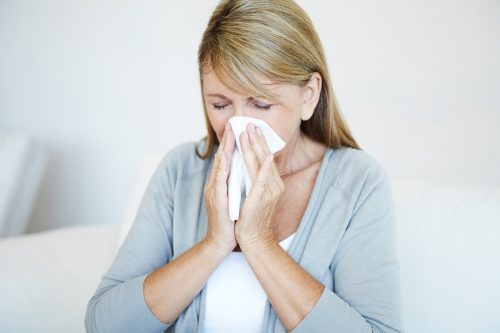
Stop a cold dead in its tracks before it stops you – we show you how.
Prevention
Boost your immunity
You don’t catch a cold; a cold catches you. When your immune system isn’t functioning at its best, viruses, bacteria, fungi and parasites take over and that tickle in your throat sets in. The best way to prevent a cold is to arm your immune system with full fighting power. Do this by following a healthy lifestyle.
Eating a healthy, balanced diet full of fresh vegetables and fruit, lean protein and healthy fats will provide a good basis. Getting enough iron, zinc and vitamins A, C, E, B6 and B12 will support your working immune cells. Too much fat will slow your immune system dead in its tracks. Exercising regularly, getting enough sleep, managing stress, limiting alcohol and caffeine, and avoiding smoking also boost your immunity.
Avoid catching a cold
We all know colds and flu can be passed on simply by coughing, sneezing or touching surfaces, so make it a habit to regularly wash your hands, as this reduces the likelihood of you developing respiratory tract infections.
Try to limit your contact with people suffering from colds and flu. If you can’t keep your distance from people like family members, as well as washing your hands frequently, keep the surfaces in your house clean with germ-killing, anti-bacterial disinfectant from your local supermarket.
Get a flu shot
The effectiveness of the flu vaccine depends on the influenza circulating that year. If scientists predict the strains correctly, the flu injection can reduce your risk of developing the flu by 70-90%. A new flu injection is needed each year as the flu vaccine from one year will not protect you from a newer strain, and the immunity from any one injection runs out over time.
A flu shot is the best way to prevent and control the flu, however antiviral drugs can also be prescribed by your doctor. For people 65 years or older, and younger people with certain chronic medical conditions, the flu vaccine is free.
Treating a cold
Shortening a cold
Vitamin C: A review of studies found that taking 200mg or more of vitamin C as a preventative measure was effective in reducing the incidence of getting a cold only in people exposed to significant cold and/or physical stress (including people like soldiers and marathon runners). The incidence of getting a cold did not change in any of the community studies.
Some studies have found taking vitamin C before the onset of a cold reduces the duration and severity, but by very small amounts. It is possible the variation of effect depends on how much vitamin C is in the normal diet, so we recommend including foods rich in vitamin C every day. Try blackcurrants, capsicum, kiwifruit, broccoli, strawberries, cauliflower and citrus fruits.
Zinc: Zinc supplementation has been considered a way of reducing the duration of colds and flu, as it plays an important role in maintaining immune function. While zinc lozenges have been thought to reduce the duration and symptoms of a cold, research has only found weak evidence to support this. In fact, doses of zinc above 30mg can cause stomach upset or vomiting, and prolonged excessive zinc supplementation can lead to copper deficiency. Instead, get enough zinc by eating foods like lean meats and shellfish, low-fat dairy products, whole grains, beans and nuts.
Echinacea: Probably the most recognised herbal supplement for the prevention and treatment of colds and flu. Currently there is controversy over whether echinacea is effective in treating colds and flu. Some studies show that echinacea reduces the duration of colds, while others fail to show any difference. All we can say is more research is needed in the use of echinacea in immune function.
Garlic: Studies on the use of garlic to treat a cold are minimal. However, one study did show people given an allicin-containing garlic supplement had a shorter duration of illness, as well as being less likely to develop a cold. Garlic seems to be most effective when used as a preventative, so why not make a habit of including garlic in your cooking, as it may have many other health benefits as well?
Fluids: Fluids help to ease the symptoms associated with colds and flu. Warm fluids such as soup or herbal teas can help loosen mucus and keep your throat moist. Avoid alcohol and caffeine-containing drinks as they have a drying effect. And of course, drink plenty of water.
Relieve the symptoms
Aches and pains: Slow down, rest and get extra sleep. You could also try a hot pack as you relax in bed.
Coughs: Honey has been shown to ease coughing and improve sleep in people with colds and flu.
Fever: Keep up the fluids such as water, soup and non-caffeinated beverages. Fluids will keep you hydrated, make you feel better and loosen any mucus.
Sore throat: Gargle with warm, salted water to relieve a sore throat. Warm vegetable soup is also a great way to ease the pain.
What ails me?
Cold
What is it: Colds are mild infectious diseases caused by more than 100 different viruses. Of all colds, rhinoviruses and coronaviruses are responsible for
50-70%.
Who gets it: Cold viruses are the most infectious diseases that we contract. Adults average two to four days per year with a cold, while children average six to 10 days, depending on their age.
Signs and symptoms: Symptoms usually start with a tickle in your throat, followed by sneezing, coughing, a runny nose and general fatigue.
Duration: Some colds can last for less than 24 hours; others may last up to 10 days.
Flu
What is it: An acute respiratory illness caused by the influenza virus.
Who gets it: Influenza affects every age group, but children and adults over the age of 65 years are most likely to develop the flu.
Signs and symptoms: Being more severe than the common cold, influenza causes fever, headaches, muscle aches and a strong cough.
Duration: The fever may last for up to five days, and the illness usually resolves within three to seven days. A cough and general fatigue can last for weeks.
Bronchitis
What is it: Inflammation of the lining of the airways, which is usually caused by viruses or smoking.
Who gets it: Affects both adults and children, more so during the winter months.
Signs and symptoms: The most common sign of bronchitis is a cough that ‘brings up’ yellow-green mucus, indicative of infection. A sore throat and chest, fever, breathlessness and fatigue may also occur.
Duration: Acute bronchitis comes on suddenly, causes severe symptoms, but only lasts a couple of weeks. Chronic bronchitis lasts longer.
Pneumonia
What is it: A contagious lung infection caused by viruses, bacteria or fungi, or by inhaling foreign substances. The lungs fill with mucus or fluids and cannot function properly, meaning oxygen cannot reach the blood and the cells.
Who gets it: One in 100 people get pneumonia each year.
Signs and symptoms: Characterised by fevers, flu symptoms, chest pain and rapid, shallow breathing. Sometimes associated with headaches, confusion, fatigue and loss of appetite.
Duration: With treatment, most bacterial pneumonias can be cured in one to two weeks. Viral pneumonias may take longer.
www.healthyfood.com










